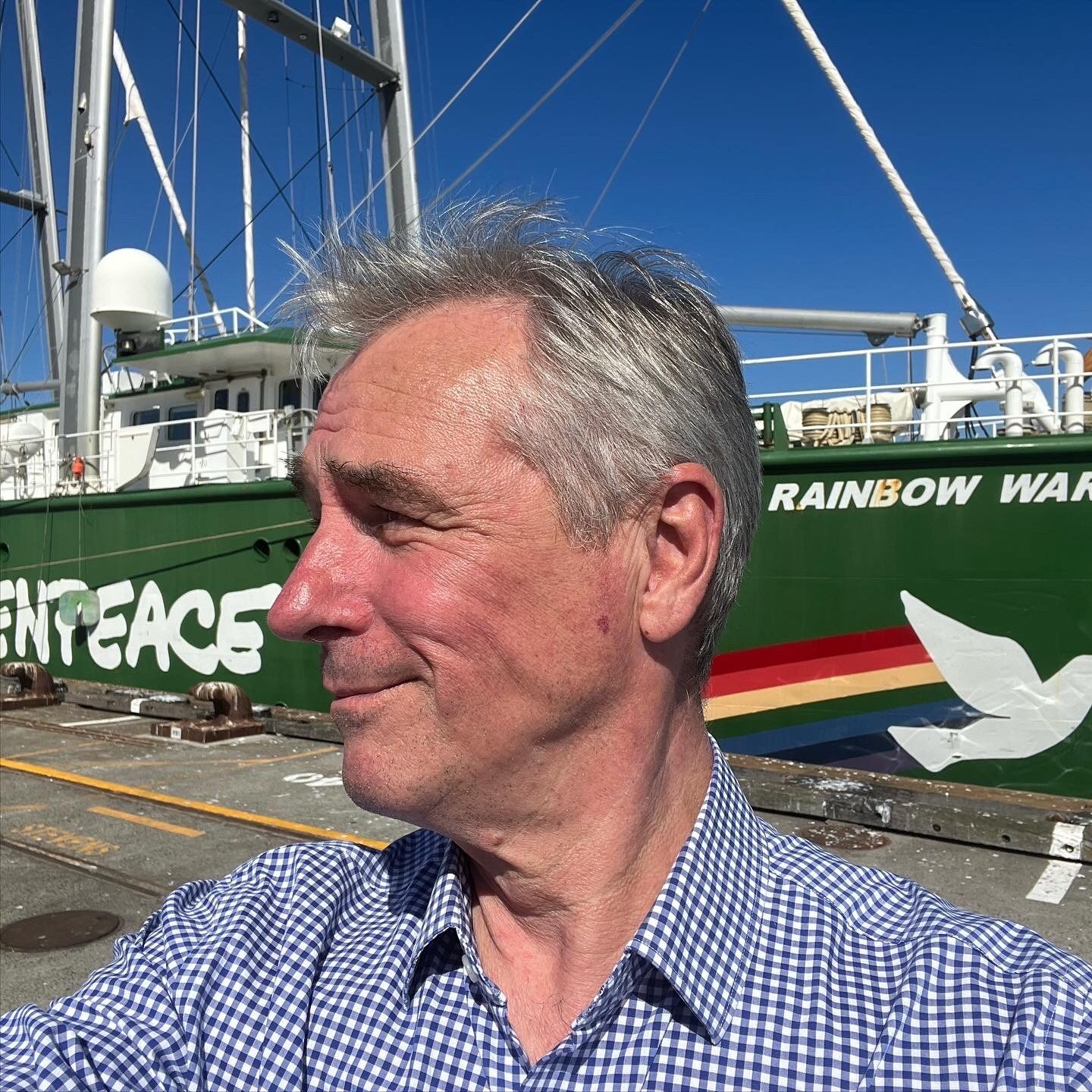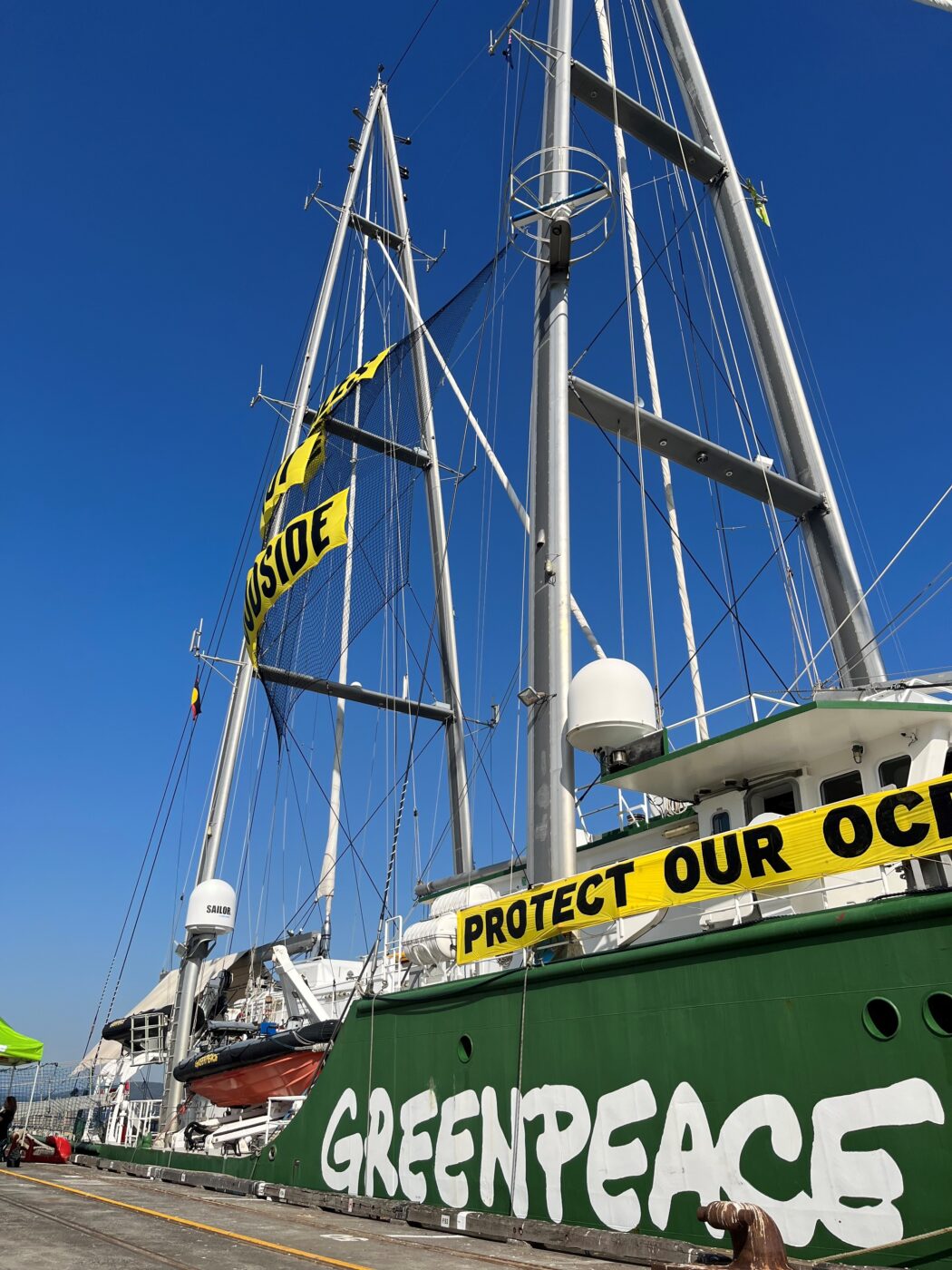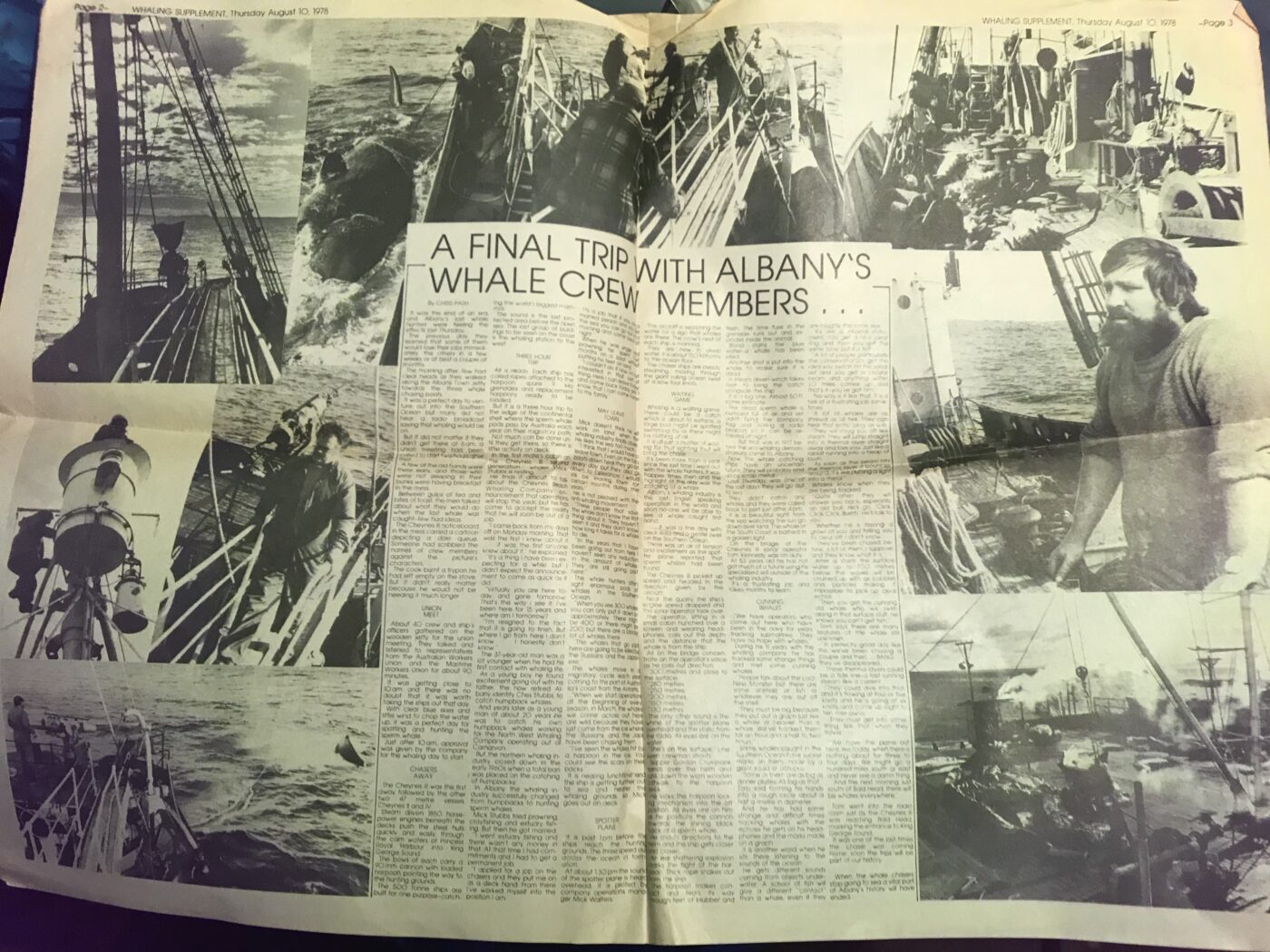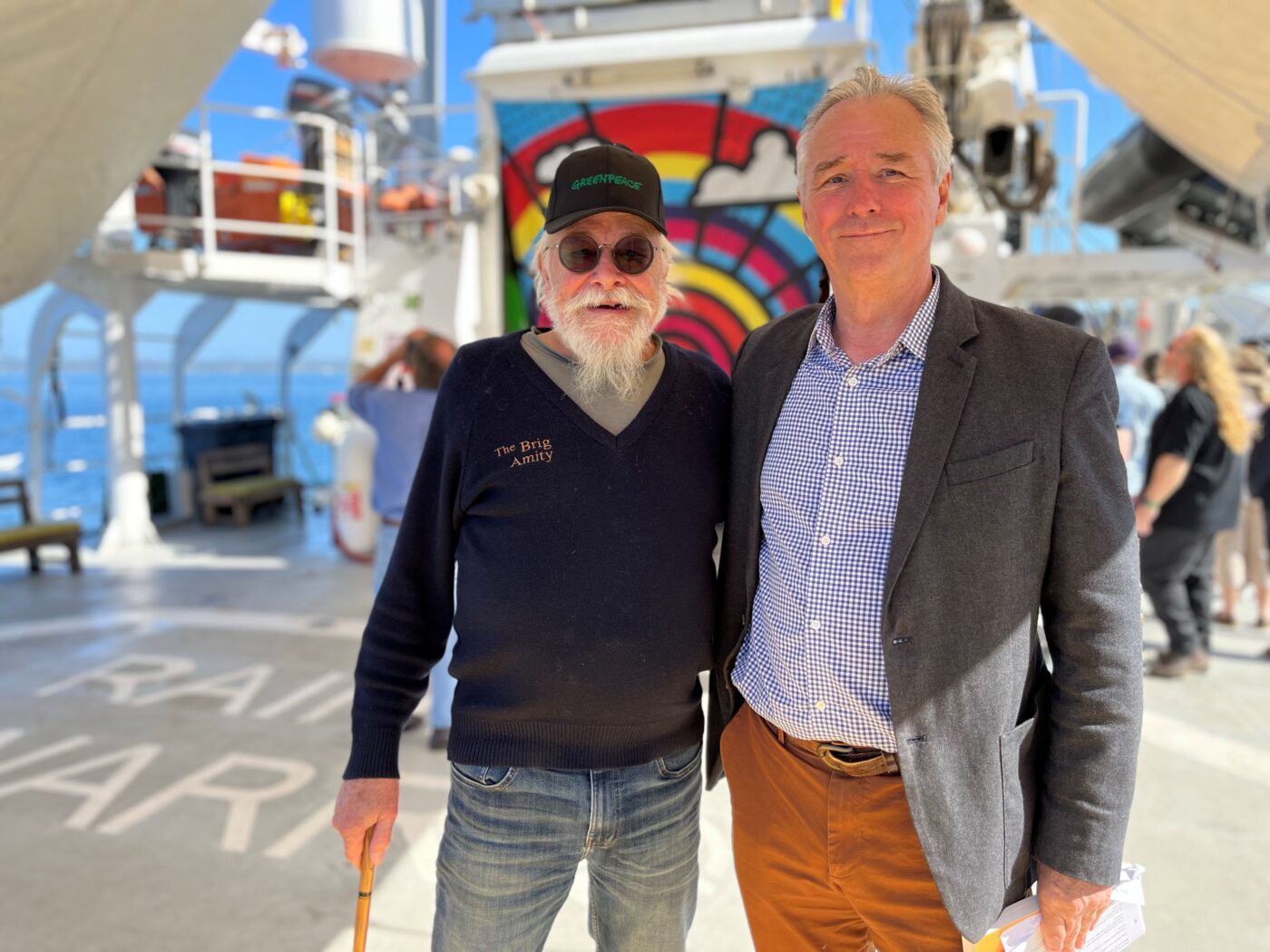45 years after whaling ended in Albany, a community reunites, and the Rainbow Warrior returns to shine her light on the plight of our fragile oceans

Author of The Last Whale, Chris Pash, shares messages of hope from two anti-whaling activists as he marks the return of the Rainbow Warrior to Albany, where she docked ahead of a campaign to sail up the coast of Western Australia to document the wildlife and environment threatened by Woodside Energy’s plans to drill for gas for a Burrup Hub mega project.
This time I see no pitchforks out for the arrival of Greenpeace.
The first time, in 1977, could best be described as a contest between gnats and an eagle.
A form of theatre, designed to get the attention of the media, to create a mindbomb.
The direct action was exquisitely audacious. And crazy.
Back then, the activists, led by Canadian Bob Hunter, the first president of Greenpeace, had two Zodiacs – open boats – which they took over the horizon to place themselves between harpoons and sperm whales.
They had no backup boat. If anything went wrong, they were on their own.
Nothing like this magnificent purpose-built ship, the latest Rainbow Warrior.

The target then was the whaling station in Albany, which was the last in Australia and the last in the English-speaking world – now a museum, a world-beating and magnificent community resource with a whale-chaser ship to explore on dry land.
It’s great to catch up with so many people, many of whom used to work at the whaling station or on the chasers, and some who protested against whaling.
Of course, some major players from 1977 aren’t with us anymore, including chaser masters Paddy (James) Hart, Kase (Cees) Van De Gaag and Gordon Cruikshank.
And on the activist side, Australians Tom Barber, Jonny Lewis and Bob Hunter – all of whom went over the horizon into the Southern Ocean in open boats –- chasing the three chasers.
They had no hope really of stopping the Cheynes Beach Whaling Company.
Taking two open boats over the horizon, to chase whale ships. They would be lucky to survive.
I took photographer and activist Jonny Lewis back to Albany in 2007 and he stood looking out across King George Sound and said: ‘We went out there?’ He was amazed. He agreed it was a crazy scheme.
In 1977, many thought the aim of the activists was to beat the whalers at sea. This wasn’t it. That’s not what they were there for. That thought was too literal. Stop the chasers? No way.
This wasn’t a physical fight. What the direct-action crew had was Bob Hunter. He coined the term ‘media mindbomb’.
The strategy was to lob information, the images of dying whales, into the minds of media consumers, preferably those watching television. The aim was to change public opinion.
Remember that the internet wasn’t around, and mobile phones were decades away. A mass-media message had to make a big splash on the highways of traditional media. Today, you can build support gradually via digital media.
Then, most Australians didn’t have any idea that Australia was whaling. Their knowledge of whales was from reading Moby Dick. So the plan was to get the message out nationally, and internationally, that Australia was whaling and that it was cruel and unnecessary.


In Albany, whaling was a big employer and part of the town’s identity. So the activists didn’t get much applause.
Zodiacs launched from Middleton Beach in the dark because they needed the cover to make sure they could follow the three whaler chasers as they came out of the harbour here.
I’d like to call out Henk Manussen, who was a member of the direct action in 1977, and who still lives in Albany today. He stayed with the team. He kept going when many faded away. He was there in the freezing waters, pushing the Zodiacs past the breakers.

Despite its modest resources, that campaign was the first by Greenpeace outside North America, and you could say that Albany was the birthplace of Greenpeace International. That, in Australian society, probably needs a plaque.
And that campaign did – as Bob Hunter planned – create headlines here and around the world.
While it didn’t stop whaling dead in its tracks, the whaling station closed the next year – the result of a few factors. But a key one was that the market for sperm whale oil collapsed as buyers, seeing a threat to supply from Greenpeace action across the world, switched to alternatives.
The closure was announced on the first day of hearings of a judicial inquiry into whales and whaling, established by then prime minister Malcolm Fraser because of public opinion. Years later, he told me that he got more letters about whaling than he did about any other issue.
Bob Hunter’s mindbomb and, of course, the work of many, had worked.
I’m in regular contact with a few from those days in 1977.
Bobbi Hunter, the first treasure – read fundraiser – of Greenpeace, who was here in 1977 with her husband Bob, has just released a book, Mr Mindbomb, about Bob Hunter. There’s a chapter in it about Albany, written by me.
On 22 April 2023, Bobbi Hunter sent me a message to be shared:
To the Crew of the Rainbow Warrior
Today is Earth Day. It is also my anniversary of the day that I married Bob Hunter in 1976. For me it is a day to celebrate and reflect.
Greenpeace was started by a handful of passionate people in 1971 and has evolved to the organisation that it is today. My husband, Bob Hunter, was there at the start as a popular local news reporter. He was on the first ship to Amchitka to stop insane nuclear testing and along the way he lost his objectivity but in return found his meaning in life. He was a brilliant charismatic leader who became the first President and guiding light of Greenpeace. He would be proud of all the current day Environmental crusaders and he would be proud of Chris Pash for being a messenger for the planet.
The Rainbow Warrior has special meaning to Bob and I. Bob read the original Rainbow Warrior story as is told in an indigenous story book and adapted it to become a key symbol for the early Greenpeace campaigns. Its core meaning is one of a hopeful path of shared concern for the planet.
Bob and I also had a key role in the purchase of the original Rainbow Warrior ship. The first Rainbow Warrior was originally called the Sir Thomas Hardy and was renamed the Rainbow Warrior at Bob’s request.
That ship was purchased directly after we came down to Australia in 1977 to help the Australian group of crusaders shut down the last land-based whale station in Australia.
We felt in the mid ’70s that we had won the battle to save the planet after we came back from many hugely successful anti-whaling campaigns. As Bob said, “The war has been won, it is now just a two hundred year mop-up operation.” Maybe that was vastly optimistic, but one must be an optimist to stay on for any length of time as an Eco Warrior.
I thank you for your crusading spirit. Please continue with this difficult and most important mop-up operation.
And here’s another message, this time from Aline Charney Barber, who was on the campaign with her husband-to-be, Tom Barber, nicknamed ‘Two-harpoon Tom’ because he had a couple of close encounters with the aim of gunners on the chasers.
One of those gunners was Paddy Hart who, when I brought Jonny Lewis back to Albany in 2007, apologised and said: ‘We wouldn’t have hurt you.’
Jonny, who some will recall was the son of a NSW premier (Tom Lewis), also apologised for essentially being a bit (a lot of) of a smart arse.
Aline’s message to me was this:
I’ve known Chris Pash many years, including sharing the celebration of the 30th anniversary of Greenpeace Australia at the Carriageworks in Sydney. It brought together the group of us that were involved with going to Albany in 1977 to protest and try and close down the last whaling station in the English-speaking world. I’ve also collaborated on his wonderful book The Last Whale, and more recently a small contribution to the book, Mr Mindbomb, the story of Bob Hunter. We have remained friends throughout the years.
The same with Bobbi Hunter, Richard Jones, Stephen Jones. Sadly Jonny Lewis, Tom Barber and Bob Hunter have passed away, all powers. I was part of the original group of people that was involved with the Whale and Dolphin coalition, created by Jonny Lewis, who drove across to Albany from Sydney carrying the Zodiacs.
I’m proud to say that our efforts made a difference in the final closure of Cheynes Beach Whaling Station. Also that it resulted in the creation of Greenpeace Australia. It brought together a most interesting group of people from all points of the globe, primarily Aussies, I was an American. There was Bob and Bobbi Hunter from Canada, Jean Paul Fortom-Gouin from France.
This wasn’t a slick operation, but it was successful because of the combination and character of the people involved … it wouldn’t have happened otherwise. The conditions were terrible and the Zodiacs going out to sea was on one hand mad but also courageous. Tom Barber and I fell in love on the frontlines and later married.
We went on to the US, where in California Tom designed and helped build the first commercial wind farms in the world. He was an Australian architect, an environmentalist, and I truly believe our prior experience in Albany, our experience with the locals, helped us prepare in how we related and connected with the community.
With all that is negative going on in the world, it’s so important especially for the young that they learn and see success and positivity. That one can and should make a difference no matter in what form, each in their own way.
You pick your battles. When I look at Albany today, where whale watching is the primary tourist attraction, where a wind farm is generating the electricity of the town, it swells me with pride. This is not the time to give up or give in. Our oceans are under attack. The ocean peoples must be protected.
Thank goodness for Greenpeace … It’s mind boggling that it’s been 45 years since whaling was stopped in Albany and wonderful that the Rainbow Warrior is coming to honour and celebrate it. Also to honour the start of Greenpeace Australia, as well as continue up the coast to join local communities to protest Woodside’s terrible plans for offshore gas drilling. It has to be stopped and there should be a moratorium throughout the Pacific.
I’ve always believed that Save the Whale, Save Man, the same thing. Wishing much success … and a whale of celebration. I will be there in spirit.
After sailing to the North West, the Rainbow Warrior will continue on a Pacific Islands tour to highlight the threat climate change poses to Pacific Island nations and to build awareness and take testimonies to support a momentous human rights climate change case soon to go before the International Court of Justice in The Hague, The Netherlands.
Chris Pash was a cadet reporter at the Albany Advertiser 1975–78. He wrote The Last Whale (Fremantle Press 2008) about the final days of whaling in Australia from the point of view of Australia’s last whalers and the activists who tried to stop them. Their direct action, headed in Albany by Canadian Bob Hunter, the first president of Greenpeace, was the first campaign outside of North America, and could be described as the birth of Greenpeace International.
Books referred to:
Mr. Mindbomb. Eco-hero and Greenpeace Co-founder Bob Hunter — A Life in Stories, edited by Bobbi Hunter, Rocky Mountain Books, 2023.
The Last Whale, Chris Pash, Fremantle Press, 2008.


